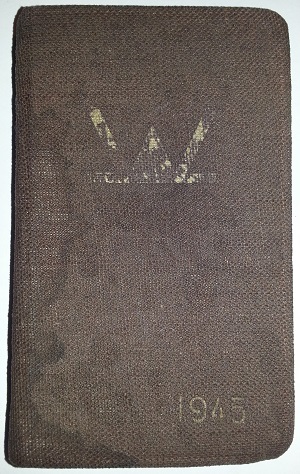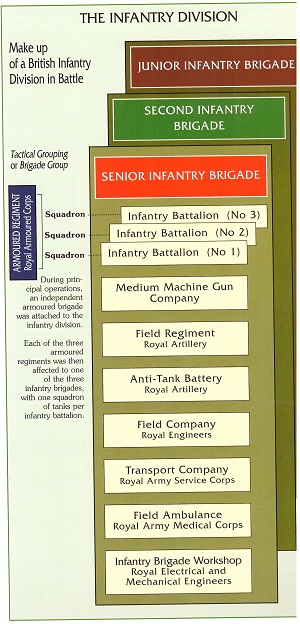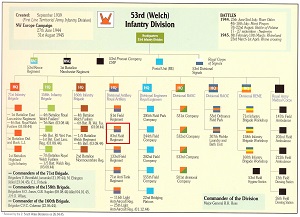Preface
In July 2017 I bought a 1945 diary of a 53rd Division soldier at the War and Peace Show.In this chapter I have transcribed the complete diary for everyone, who is interested in the history of the 53rd Welsh Division.
I only transcribed those parts, which I could make out properly. All parts that I could not decipher, I have marked with a red question mark (?). For some words I have made a best guess, but I'm not sure. These words are written in red.
Furthermore I have compared the discriptions in the diary with the history of the 53rd Division from different literature sources. For those parts where I found interesting corresponding parts in literature I have quoted these text sections. I think that this makes a good connection between the personal view of a single soldier and the more generic view of military literature.
In general the diary consists of a woven cover with the divisional marking of the 53rd welsh division as well as the year 1945 imprinted in the front cover. The single pages of the diary a preprinted with a calendar in french language, where each double page encompasses a complete week. The left page always comprises the days from Sunday until Wednesday, the right page covers Thursday until Saturday and a field for notes.
I have not been able to determine the author of the diary with certainty. At the top of the first page a name seems to be written:
|
[ID-Nr.] L/Bdr [Last name] 460/83rd Field Regt RA BLA |
The first line seems to include the ID-Nr. and the last name of the author. Since the diary also contains several personal descriptions
I do not want to put the ID and the name on this homepage.
Nevertheless, based on this entry I assume that the author of the diary belonged to the 83rd Field Regiment of the Royal Artillery.
The abbreviation 'L/Bdr' is just a best guess, since it is hard to read, but it would fit, since this is the abbreviation for
lance-Bombardier, an Artillery-rank equivilant to the Infantry-rank of lance-Corporal. For more information on this rank refer to
Wikipedia: Bombardier/lance-Bombardier.
According to the following source (wartimememoriesproject) the 83rd Field Regiment
consisted of the following Batteries:
- 329th Battery
- 330th Battery
- 460th Battery
The 83rd Field Regiment was indeed part of the 53rd division. Many descriptions in the diary also indicate that the author belonged to the Artillery rather than infantry, e.g. on 21st April the author writes: "Everyone getting rather tired of moving up so close to the infantry. Even infantry dont want us so close up."
Some descriptions also indicate that the 83rd Field Regiment could be correct, since the descriptions go with the corresponding descriptions in literature about the 83rd Field Regiment.
At this point I want to give a short overview about the organisational structure of the 53rd Welsh Division, since the quoted literature often refers to these organisational units.
In the second volume of his book series, Jean Bouchery gives a good overview of this structure:
During WWII, a british Infantry Division consisted of three Infantry Brigades (Junior, Second and Senior Infantry Brigade).
Each of these Brigades again consisted of three Infantry Battalions (Junior, Second and Senior Infantry Battalion). Furhtermore, to each Brigade
several support services were attached, like a Field Company of the Royal Engineers, a Field Ambulance of the Royal Army Medical Corps and also a Field Regiment
of the Royal Artillery.
The following picture shows the particular structure of the 53rd Welsh (Infantry) Division (The 83rd Field Regiment Royal Artillery is specifically marked):
At the beginning of 1945 the following structure was valid for the 53rd Division:
- Senior Brigade: 71st Infantry Brigade
- Senior Battalion: 4th Bn The Royal Welch Fusiliers
- Second Battalion: 1st Bn The Oxford and Buckinghamshire Light Infantry
- Junior Battalion: 1st Bn Highland Light Infantry
- Second Brigade: 158th Infantry Brigade
- Senior Battalion: 7th Bn The Royal Welch Fusiliers
- Second Battalion: 1st Bn The East Lancashire Regiment
- Junior Battalion: 1/5th Bn The Welch Regiment
- Junior Brigade: 160th Infantry Brigade
- Senior Battalion: 6th Bn The Royal Welch Fusiliers
- Second Battalion: 4th Bn The Welch Regiment
- Junior Battalion: 2nd Bn The Monmouthshire Regiment
- 81st Field Regiment
- 323rd Battery
- 324th Battery
- 459th Battery
- 83rd Field Regiment
- 329th Battery
- 330th Battery
- 460th Battery
- 133rd Field Regiment
- 331st Battery
- 332nd Battery
- 497th Battery
I have not been able to find an absolute proof for this assignment, but the book of Major Hughes gives a good picture, how the Artillery was attached to the Infantry:
"Major Hughes was the Commanding Officer of 497 Battery, 133rd Field Regiment of the Royal Artillery. This battery was assigned to support The Mons througout the 1944-45 campaign in Europe, and it was integral with the infantry battalion at all times." (Hugh16, p.12)'The Mons' refers to the 2nd Battalion The Monmouthshire Regiment. As stated above, this battalion was the Junior battalion of the 160th Infantry Brigade. This shows, that the 133rd Field Regiment was attached to the 160th Infantry Brigade, and in particular the 497th Battery to the 2nd Bn The Mons. Therefore I assume that the 83rd Field Regiment was attached to the 158th Brigade.
From these dates I assume, that also in Artillery Field Regiments the Batteries were some how categorised in Junior, Second and Senior Batteries. The attachment of the 497th Battery to the 2nd Bn The Mons indicates that e.g. the Junior Battery of a Field Regiment was attached to the Junior Battalion of the Infantry Regiment. Following this logic, I assume that the 460th Battery - to which the author of the diary seemes to belong - was attached to the 1/5th Bn The Welch Regiment of the 158th Brigade.
Why am I bringing this up at this point? The quoted literature often refers to the above mentioned structures of the Infantry Brigades and Battalions. The Field Regiments, however, are not often mentioned directly. The link between the Infantry Brigades/Batallions and the Artillery Field Regiments therefore helps to connect the content of the diary with the other literature sources.
Before we come to the actual content of the diary, I want to give a short overview about the particular literature I used for the commparison with the diary:
- The history of the 53rd (welsh) division in the second world war, C.N. Barclay, 1956
- Red Crown & Dragon - 53rd Welsh Division in North-West Europe 1944-1945, Patrick Delaforce, 1996
- Sheldrake - Memories of a Second World War Gunner, Major Richard Hughes, 2016
"It was therefore decided to produce a more modest history, in one volume of between two and three hundred pages with sufficient, but not a superfluity of, maps and illustrations. It was to be a book for the intelligent general reader and those who wished to refresh their memories of events in which they participated, rather than a book of reference for military students. I have done my best to meet this requirement. Nevertheless, I am very conscious of the fact that I have given a mere outline of the story and that much gallantry, and work of outstanding merit, remains unrecorded." (Barc56, p. xv)The last book, however, was written by Major Hughes, a commander of an artillery battery in the 53rd Division. This author thus describes the journey of the division much more personally and especially from the point of view of this individual artillery battery. Thus the last book gives a similar perspective as the author of the present diary.
The comparison of the diary with these different books therefore serves, on the one hand, to place the very personal descriptions in the diary into the overall picture. On the other hand, by looking at individual events from several - also more general - sides, a more complete picture of these events becomes possible.
I think this is enough background information to understand the diary. In the next sections the transcript of the diary follows. Since it seems that some of the entries stretch out over several days of the diary, I have tried to group the days into reasonable chapters. Every chapter contains on the left side a picture of the relevant entries for the respective days, and on the right side the transcription of the entries.
Subsequently the relevant quotes from literature follow.



